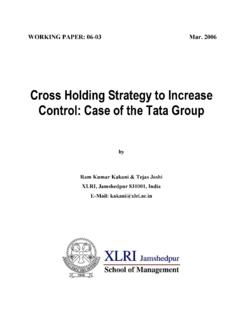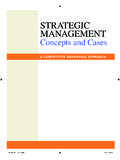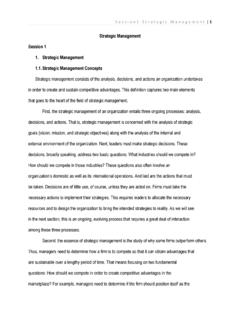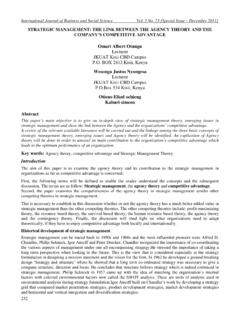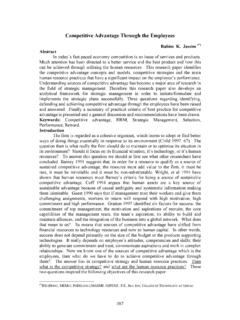Transcription of Management, Strategic Management Theories and …
1 European Journal of Social Sciences Volume 11, Number 3 (2009) 402 Management , Strategic Management Theories and the Linkage with Organizational competitive Advantage from the Resource-Based View Raduan, C. R Faculty of Economics & Management , Universiti Putra Malaysia 43400 Selangor, Malaysia E-mail: Jegak, U Faculty of Educational Studies, Universiti Putra Malaysia 43400 Selangor, Malaysia E-mail: Haslinda, A Faculty of Economics & Management , Universiti Putra Malaysia 43400 Selangor, Malaysia E-mail: Alimin, I. I Graduate School of Management , Universiti Putra Malaysia 43400 Selangor, Malaysia E-mail: Abstract The main objective of this paper is to review the evolution of Management theory, overview of Strategic Management theory and its linkage with the resource-based view (RBV) of the firm s competitive advantage.
2 A review of the relevant literature was conducted and a connection between Management theory, Strategic Management theory and competitive advantage from the RBV of the firm was identified. It was found that the RBV of the firm s competitive advantage is one of the main Strategic Management Theories applicable to explain organizational performance, and it is also a part of the larger Management theory family which has evolved to suit the managerial needs of the organizations and also the business environments organizations are operating in. Examining organizational competitive advantage from the RBV allows the organization to gauge the magnitude of importance placed upon its internal firm resources and capabilities in particular towards attaining a competitive advantage level, thus providing further support and extension to the RBV.
3 Keywords: competitive advantage, resource-based view (RBV) and firm performance 1. Introduction Achieving a competitive advantage position and enhancing firm performance relative to their competitors are the main objectives that business organizations in particular should strive to attain. competitive advantage is a concept that remains as a major research area as far as Strategic European Journal of Social Sciences Volume 11, Number 3 (2009) 403 Management is concerned. Moreover, as far as global and local businesses are concerned, competitive advantage is important. In order to compete and sustain successfully, locally and globally, businesses must not only excel in their area but also persevere in the long run. Achieving such a sustainable competitive advantage status is not an easy task without a proper road map or strategy being outline and put into practice.
4 competitive advantage is a result from and being associated with a long list of contributing factors. Such factors include operational efficiencies, mergers, acquisitions, levels of diversification, types of diversification, organizational structures, top Management team composition and style, human resource Management , manipulation of the political and/or social influences intruding upon the market, conformity to various interpretations of socially responsible behaviours, international or cross-cultural activities of expansion and adaptation, and various other organizational and/or industry level phenomena (Ma, 1999a, 1999b; Flint and Van Fleet, 2005; King, 2007b). Indeed, the concept of competitive advantage has been in existence since International businesses and Multinational Corporations (MNCs) such as Sony, Toyota and Intel have achieved and sustained their competitive advantage via various Strategic Management practices and approaches.
5 However, the question that arises is the underlying epistemology of competitive advantage in Management and business. Hence, a review of the existing literature examines the evolution of Management theory, the overview of Strategic Management strategy and the linkage with competitive advantage, particularly from the resource-based view perspective. 2. The Evolution of Management Theory Management theory provides a simple conceptual framework for organizing knowledge and for providing a blueprint for action to help guide organizations toward their objectives. Contributions from past industrialists have molded the organizational system and culture, and managers can benefit from an awareness of these contributions. As such, scientific Management can be seen as the starting point from where the managerial aspect of organizations are systematically being analyzed and improved for practical application in the day to day running of organizations (Cole, 2004; DuBrin, 2006).
6 As with any modern theory, scientific Management theory is also subject to criticism and has evolved with time to suit the needs of organizations and the environments they are operating in. This is the crucial factor for survival, being able to adopt and adapt to the needs of the surroundings, without foregoing the basic or fundamental structural beliefs of the concept or notion being uphold. Following Sheldrake (2003), Cole (2004) and DuBrin (2006), an overview of the Management theory evolution is presented in Figure as per the Management Theory Chart. The Management Theory Chart shown in Figure tries to encapsulate the Management theory evolution spanning from the period 1900 to 2000. The development and progressive nature of the Management theory indeed captures the dynamism of Management theory being responsive and adaptive to the internal and environmental needs of evolving organizations.
7 The chart anchors on several approaches and perspective, namely: i) the classical approach, ii) the human resource approach, iii) the quantitative approach, iv) the systems perspectives, v) the contingency approach, and vi) the information technology approach. The Classical Approach The classical approach to Management encompasses scientific Management and administrative Management . The scientific Management is the application of scientific methods to increase individual workers productivity, mainly developed by Taylor, Gantt and Frank & Lillian Gilbreth. On the other hand, the administrative Management was concerned with the use of Management principles in the structuring and managing of an organization, primarily contributed by Fayol and Weber.
8 European Journal of Social Sciences Volume 11, Number 3 (2009) 404 The Human Resource Approach The human resource approach very much applied the psychological aspect of human nature to manage organizations, emphasizes managing people by understanding their psychological makeup and needs. Among the major contributors to this approach are the Hawthorne studies or effect (the phenomenon in which people behave differently in response to perceived attention from evaluators), McGregor s Theory X and Theory Y (assumptions about human nature with regards to work and responsibility), and Maslow s hierarchy of needs (ranging from basic needs to those for self-actualization). The human resource Management (HRM) and organizational behaviour (OB) Theories very much stems from this approach.
9 The Quantitative Approach This approach is a perspective on Management that emphasizes the use of a group of methods in managerial decision making, based on the scientific method. This approach is referred to as Management science and/or operations research, which adopted quantitative tools including statistics, linear programming, decision trees, and network analysis. Among the managerial applications are those of inventory control and quality control. The Systems Perspective This perspective adopted the view that an organization is a system, or an entity of interrelated parts. Among the Management Theories applicable from this view is the HRM & OB (including that of organization theory - domestic, international, & virtual enterprises), resource-based view (RBV) (the theory of competitive advantage), Strategic Management (SM) Theories of competitive advantage and collaborative advantage (including that of industrial-organization [I/O] perspective), and competence and innovation (C & I) theory.
10 The systems perspective is vital since the interaction and interlinking of internal resources, capabilities and systems very much explain the dynamism and adaptive nature of organization towards its environment. The Contingency Approach This is a perspective on Management that emphasizes that no single way to manage people or work is best in every situation. It encourages managers to study individual and situational differences before deciding on a course of action. The Management Theories that are applicable from this view are Strategic Management (SM) Theories of competitive advantage and collaborative advantage (including that of industrial-organization [I/O] perspective), and competence and innovation (C & I) theory. This is due to differing environmental and organizational needs and structures that affect an organization, coupled with differing resources and capabilities pertaining to individual organization.

